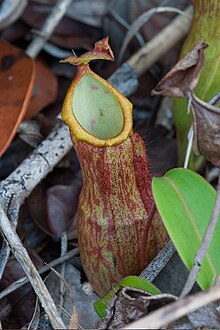Nepenthes philippinensis /nɪˈpɛnθiːz fɪˌlɪpɪˈnɛnsɪs/ is a tropical pitcher plant endemic to the Philippines. It is known from Palawan and the neighbouring Calamian Islands (including Busuanga, Coron, and Culion) and Linapacan, where it grows at 0–600 metres (2,000 ft) above sea level.[8][9]
| Nepenthes philippinensis | |
|---|---|

| |
| Lower pitcher of Nepenthes philippinensis growing near its type locality. Bacungan, Palawan. | |
| Scientific classification | |
| Kingdom: | Plantae |
| Clade: | Tracheophytes |
| Clade: | Angiosperms |
| Clade: | Eudicots |
| Order: | Caryophyllales |
| Family: | Nepenthaceae |
| Genus: | Nepenthes |
| Species: | N. philippinensis
|
| Binomial name | |
| Nepenthes philippinensis | |
| Synonyms | |
| |
Nepenthes wilkiei was described by Matthew Jebb and Martin Cheek in 1998.[7] This taxon was subsequently found to be conspecific with N. philippinensis.[10][11] Jebb and Cheek suggest that N. philippinensis is more closely related to the Bornean species N. hirsuta, N. hispida, and N. macrovulgaris than it is to N. alata.[10][11]
Nepenthes philippinensis produces the most concurrent inflorescences of any species in the genus; up to 190 have been recorded on a single plant.[12]
Nepenthes philippinensis has no known natural hybrids.[12] No forms or varieties have been formally described, although a multitude of taxa resembling N. philippinensis are found across the isolated peaks of Palawan.[9][13]
References
edit- ^ Clarke, C.M.; Lee, C. (2014). "Nepenthes philippinensis". IUCN Red List of Threatened Species. 2014: e.T49000838A49009847. doi:10.2305/IUCN.UK.2014-1.RLTS.T49000838A49009847.en. Retrieved 19 November 2021.
- ^ Macfarlane, J.M. 1908. Nepenthaceae. In: A. Engler. Das Pflanzenreich IV, III, Heft 36: 1–91.
- ^ Danser, B.H. 1928. 1. Nepenthes alata Blanco. [pp. 258–262] In: The Nepenthaceae of the Netherlands Indies. Bulletin du Jardin Botanique de Buitenzorg, Série III, 9(3–4): 249–438.
- ^ Cheek, M. & M. Jebb 2013. Typification and redelimitation of Nepenthes alata with notes on the N. alata group, and N. negros sp. nov. from the Philippines. Nordic Journal of Botany 31(5): 616–622. doi:10.1111/j.1756-1051.2012.00099.x
- ^ Clarke, C. & C.C. Lee 2012. A revision of Nepenthes (Nepenthaceae) from Gunung Tahan, Peninsular Malaysia. Archived 2013-10-07 at the Wayback Machine Gardens' Bulletin Singapore 64(1): 33–49.
- ^ Schlauer, J. N.d. Nepenthes alata. Carnivorous Plant Database.
- ^ a b Cheek, M.R. & M.H.P. Jebb 1998. Two New Philippine Nepenthes. Kew Bulletin 53(4): 966. doi:10.2307/4118886
- ^ McPherson, S.R. & V.B. Amoroso 2011. Field Guide to the Pitcher Plants of the Philippines. Redfern Natural History Productions, Poole.
- ^ a b McPherson, S.R. 2011. Observations of Nepenthes philippinensis and related taxa. In: New Nepenthes: Volume One. Redfern Natural History Productions, Poole. pp. 382–395.
- ^ a b Cheek, M.R. & M.H.P. Jebb 1999. Nepenthes (Nepenthaceae) in Palawan, Philippines. Kew Bulletin 54(4): 887–895. doi:10.2307/4111166
- ^ a b Schlauer, J. 2000. "Literature reviews" (PDF). Carnivorous Plant Newsletter 29(2): 53.
- ^ a b McPherson, S.R. 2009. Pitcher Plants of the Old World. 2 volumes. Redfern Natural History Productions, Poole.
- ^ Exploration of Mount Anipahan and Mount Kiamo Archived 2014-06-06 at the Wayback Machine. [video] Redfern Natural History Productions.
Further reading
edit- Co, L. & W. Suarez 2012. Nepenthaceae. Co's Digital Flora of the Philippines.
- Cullen, D. & B. Quinn 2012. Exploring Mount Victoria, Central Palawan – revisiting the habitat of N. attenboroughii. Part 1: Mt Victoria – Peak 1 & 2. Victorian Carnivorous Plant Society Journal 105: 6–13.
- Macfarlane, J.M. 1927. The Philippine species of Nepenthes. The Philippine Journal of Science 33(2): 127–140.
- Mann, P. 1998. A trip to the Philippines. Carnivorous Plant Newsletter 27(1): 6–11.
- (in Indonesian) Mansur, M. 2001. "Koleksi Nepenthes di Herbarium Bogoriense: prospeknya sebagai tanaman hias" (PDF). Archived from the original (PDF) on 2012-03-19. In: Prosiding Seminar Hari Cinta Puspa dan Satwa Nasional. Lembaga Ilmu Pengetahuan Indonesia, Bogor. pp. 244–253.
- McPherson, S. 2011. N. attenboroughii – a new species of giant pitcher plant from the Philippines. Victorian Carnivorous Plant Society Journal 99: 12–18.
- (in German) McPherson, S. & T. Gronemeyer 2008. Die Nepenthesarten der Philippinen Eine Fotodokumentation. Das Taublatt 60(1): 34–78.
- Mey, F.S. 2013. Neotypification of Nepenthes blancoi and description of N. abalata a new species from the Philippines. Strange Fruits: A Garden's Chronicle, February 11, 2013.
